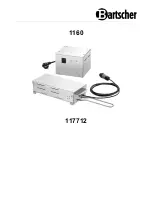
Page EN-10
The cast-iron hob
off again when
all
of the solid plates
and
the
oven are switched off.
The right cookware
d2
d1
The best thing to use is cookware for elec-
tric hobs
– with sufficient base thickness, e.g. enam-
elled steel pans with a thickness of 2-3 mm
and stainless steel pans with a thickness
of 4-6 mm.
– of a size that corresponds to the size of the
cooking zones. The d1 diameter is always
provided as a pan and pot size. d2 base
diameter is always around 2 cm smaller.
– such as energy-saving and time-saving
steam pressure cookers. The relatively
high purchase costs are quickly recovered.
– like steel pots and pans. Coated cookware
must not be scratched on the inside and
also must not be overheated.
– Only use cookware with a smooth, even
base. Dented pans are not suitable.
– Use only pots with clean and dry bases.
This will avoid damage to the hob.
C energy-saving tips
Con-
troller
posi-
tion
1)
Application / Examples
½
Gentle boiling / keeping warm, for
soaking rice
1
Boiling most dishes, for soups and
vegetables
1 ½
Gentle roasting / intense further
cooking for breaded items
2
Normal roasting e.g. roast potatoes
2½ Intense frying for quick stir-frying
3
Searing and parboiling, for potatoes,
braised meat
1)
For smaller quantities ½ level lower, for
larger quantities ½ level higher.
– To sear and parboil food, always select the
highest setting.
– Once the pot boils and steam forms or the
steak is brown on both sides, switch to a
lower level; for larger pots and pans use
the setting ‘2’, otherwise setting ‘1’ is suf-
ficient.
– Roasts weighing more than 1 kilogram are
best cooked in the oven.
– Use the right dishes and a little water/oil to
cook; this helps to preserve the vitamins.
– Use the residual heat of the solid plates.
The heat is sufficient enough for 5 to 10
minutes, e.g. for soaking rice.
Summary of Contents for 8931 7732
Page 60: ......
















































